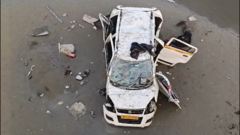In a tragic incident that has highlighted the dangers associated with navigation apps, three men lost their lives in Uttar Pradesh, India, when their vehicle veered off a collapsed bridge and fell onto a riverbed en route to a wedding. Preliminary investigations suggest that Google Maps directed the men along the ill-fated route, despite local knowledge of the bridge's unsafe condition due to prior flooding. Authorities have initiated a police complaint against four engineers and an unnamed official from Google Maps, raising the question: can a navigation app be held responsible for accidents caused by its directions?
The bridge, partially collapsed earlier this year, was left without warning signs or barricades, catching the three visitors, unfamiliar with the area, unaware of the danger. Google representatives have stated their commitment to cooperating with the investigation, while critics have raised fundamental concerns about the reliability and accuracy of information provided by navigation apps.
Google Maps enjoys immense popularity in India, with approximately 60 million active users daily. It's integrated into various ride-sharing, e-commerce, and food delivery services, yet has repeatedly faced allegations of providing misleading directions, sometimes resulting in fatal incidents. Previous accidents, including instances where drivers inadvertently drove into waterways while following Google Maps routes, further underscore the risks involved.
The app relies on user GPS data and inputs from governmental authorities to adjust and update its maps. However, experts argue that despite the app’s widespread use, the complexities of India’s road infrastructure and the lack of a robust system for capturing real-time changes hinder its reliability. As highlighted by Ashish Nair, founder of mapping platform Potter Maps, the rapid pace of infrastructural development in India poses significant challenges to maintaining accurate data within navigation systems.
Legal opinions continue to diverge on whether apps like Google Maps should be held accountable in cases of mishaps. Advocates point to the IT Act's provision that shields digital platforms from liability as intermediaries. Nonetheless, there is a possibility for legal action if it can be demonstrated that Google failed to update its information despite receiving timely alerts regarding road conditions.
The tragic accident has not only spotlighted the need for safer navigation practices but also calls for improved infrastructure reporting systems, akin to those in countries like Singapore, as India grapples with efficient data collection amidst rapid urbanization. Until significant reforms are made, experts caution that challenges to ensuring reliable navigation will persist.
The bridge, partially collapsed earlier this year, was left without warning signs or barricades, catching the three visitors, unfamiliar with the area, unaware of the danger. Google representatives have stated their commitment to cooperating with the investigation, while critics have raised fundamental concerns about the reliability and accuracy of information provided by navigation apps.
Google Maps enjoys immense popularity in India, with approximately 60 million active users daily. It's integrated into various ride-sharing, e-commerce, and food delivery services, yet has repeatedly faced allegations of providing misleading directions, sometimes resulting in fatal incidents. Previous accidents, including instances where drivers inadvertently drove into waterways while following Google Maps routes, further underscore the risks involved.
The app relies on user GPS data and inputs from governmental authorities to adjust and update its maps. However, experts argue that despite the app’s widespread use, the complexities of India’s road infrastructure and the lack of a robust system for capturing real-time changes hinder its reliability. As highlighted by Ashish Nair, founder of mapping platform Potter Maps, the rapid pace of infrastructural development in India poses significant challenges to maintaining accurate data within navigation systems.
Legal opinions continue to diverge on whether apps like Google Maps should be held accountable in cases of mishaps. Advocates point to the IT Act's provision that shields digital platforms from liability as intermediaries. Nonetheless, there is a possibility for legal action if it can be demonstrated that Google failed to update its information despite receiving timely alerts regarding road conditions.
The tragic accident has not only spotlighted the need for safer navigation practices but also calls for improved infrastructure reporting systems, akin to those in countries like Singapore, as India grapples with efficient data collection amidst rapid urbanization. Until significant reforms are made, experts caution that challenges to ensuring reliable navigation will persist.

















